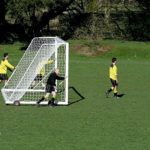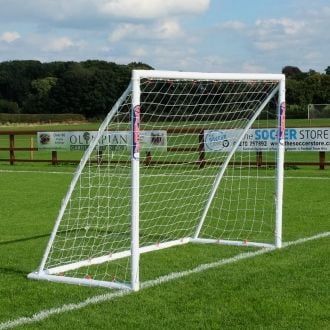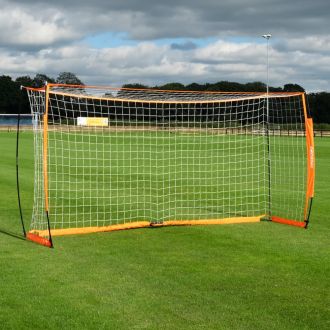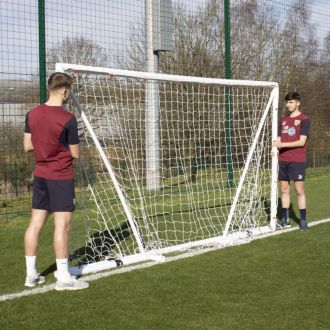Everything You Need to Know About Goalpost Safety
When was the last time you seriously considered goalpost safety? If you’re a coach, an administrator or an official in grassroots football, the safety of the goals you use should be a priority.
Not only do you need to ensure your goals meet stringent manufacturing and quality guidelines, you need to make sure that they’re regularly inspected in line with the BS8461 Code of Practice.
Ultimately, the person offering the football facilities is responsible for goalpost safety. If you’re setting up the goals, the chances are you’re accountable for them. And if that’s the case, there are a few essential safety guidelines you need to know.
Installing Goals
Safety begins with installation. You should always follow the manufacturer’s installation instructions, and use any tools and safety equipment that are provided. You should wear safety equipment or PPE as prescribed, and carry out a full risk assessment before starting. Where practicable, only those trained in installation should attempt to install permanent goalposts.
Installing Socketed Goals
Most serious safety breaches involving goalposts are related to socketed goals — the types that are permanently rooted to the ground. They must be suck into concrete, and in full accordance with the manufacturer’s instructions. The minimum concrete block size is 600mm by 600mm by 600mm, but this can differ depending on the condition of the ground. In addition, the base of the footing needs to be square with a minimum socket depth of 460mm.
If you’re a coach or someone involved in a local club, however, you should leave the installation of socketed goals to the professionals. If you rent your pitch from a private owner or a local authority, they should be the ones to safely install the goalposts.
Installing Freestanding Goals
Freestanding goals are versatile, lightweight and highly mobile. They’re also relatively safe — but only if you follow the manufacturer’s instructions and comply with all of the safety measures. For example, most freestanding goals need to be anchored to the ground in line with the instructions. However, there are exceptions for particularly small goals, such as rebounders and inflatables.
To ensure that your goals comply with the relevant British Safety Standards (BSEN 748 for full-size goals and BS8462:2012 for smaller sizes) look for products with the necessary certifications. For example, Samba Match Goals and most MH Goals products all comply with the relevant British Safety Standards.
Depending on the size of the freestanding goal you’re using, you’ll need either four or six counterweights. Only the weights and anchors provided by the manufacturer should be used. If they’re missing, either return the item or order replacements. It is unsafe and potentially negligent to anchor a goal with anything other than the official parts — so don’t look for quick fixes such as sandbags and tent hooks.
Make sure you follow the anchor and weight installation instructions to the letter. You should check the goals are properly rooted to the ground before every match or training session. It’s also important to check that goals are also anchored while they’re in storage.
Tips for Moving Goals Safely
Moving goals, erecting them and taking then down are fraught with potential for accidents and injuries. Follow these tips to minimise the risks involved:
- Remove all weights and anchors before moving or disassembling the goal
- Follow the manufacturer’s instructions to the letter
- Perform a risk assessment
- Ensure there are enough people to safely move the goalposts
- There should be enough people to carry the goalposts — never drag them
- Goals on wheels should be pushed in the way described by the manufacturer (usually backwards)
Make sure you store your goalposts somewhere inaccessible, preferably behind a locked door. Never leave them lying against walls, propped against other items of equipment or in any unstable position. Lie them flat on the floor, padlock them and ensure they’re not creating a tripping hazard. If your goalposts came with their own storage solution, use it.
Inspecting Goalposts
If you’re providing the football facilities, you’re responsible for goalpost safety. Check them for signs of fatigue, stability and strength. To demonstrate your due diligence to the authorities, make sure you always document your inspections.
You should be looking for anything that could undermine the goalpost’s safety, including broken, loose or missing pins, bolts and nuts. Other problems to look for include bent posts, broken cords and nets, firm anchoring and any missing fixings.
If you’re using mobile, freestanding goalposts, check their anchors and weights for damage and missing parts. Check that all of the parts are secure, and that any weights being used are provided by the manufacturer and appropriate for the goal size.
Never look for quick fixes or put off repairs and replacements. The consequences of an accident involving any type of goalpost can be disastrous — and you could be the person held responsible. Ideally, make your checks the day before games and training sessions, so you have time to make the necessary changes.
Safety is important to us at The Soccer Store. All of our Pro Goal Posts from Mark Harrod or Samba Sports comply to the relevant Safety Standards.




